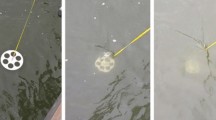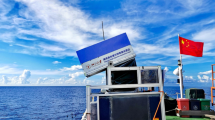Abstract
The diffuse attenuation coefficient, \( K_{d} \), is an inherent optical parameter of water. It is an important hydrologic index for both oceanography and biology. We proposed a new method to retrieve the diffuse attenuation coefficient from airborne LiDAR bathymetry data in this paper. Firstly, a formula was derived for calculating the values of \( K_{d} \) by using waveform from single laser shot. An algorithm was then deduced from the formula. \( K_{d} \) values could be retrieved from this algorithm. A case study on Wuzhizhou island in China was carried out to validate the method, it using a big Optech Aquarius bathymetry data. The results show well agreement with the MODIS products. Compared with other previous algorithms, this new algorithm could obtain the value of \( K_{d} \) from single laser shot, and the method could be applied to laser shots without bottom response even in deep or turbid water area.
Access this chapter
Tax calculation will be finalised at checkout
Purchases are for personal use only
Similar content being viewed by others
References
Baker, K.S., Smith, R.C.: Quasi-inherent characteristics of the diffuse attenuation coefficient for irradiance. In: Ocean Optics VI, pp. 60–63 (1980)
Smith, R.C., Baker, K.S.: The bio-optical state of ocean waters and remote sensing. Limnol. Oceanogr. 23, 247–259 (1978)
Guenther, G.C.: Airborne laser hydrography: System design and performance factors. National Ocean Service 1, National Oceanic and Atmospheric Administration, Rockville, MD (1985)
Mankovsky, V.I.: Relation between the diffuse attenuation coefficient and the Secchi depth. Oceanology 54, 32–37 (2014)
Zaneveld, J.R.V.: A reflectivetube absorption meter. In: Proceedings Spie, vol. 1302, pp. 124–136 (1990)
Lee, Z.P., Darecki, M., Carder, K.L., et al.: Diffuse attenuation coefficient of downwelling irradiance: An evaluation of remote sensing methods. J. Geophys. Res.-Oceans, vol. 110 (2005)
Jamet, C., Loisel, H., Dessailly, D.: Estimation of the Diffuse Attenuation Coefficient Kd(Lambda) with a Neural Network Inversion. In: IEEE International Geoscience and Remote Sensing Symposium (Igarss), pp. 114–117 (2011)
Yu, X., Salama, M.S., Shen, F., et al.: Retrieval of the diffuse attenuation coefficient from GOCI images using the 2SeaColor model: a case study in the Yangtze Estuary. Remote Sens. Environ. 175, 109–119 (2016)
Billard, B., Abbot, R.H., Penny, M.F.: Airborne estimation of sea turbidity parameters from the WRELADS laser airborne depth sounder. Appl. Opt. 25, 2080–2088 (1986)
Smart, J.H, Kang, H.K.K.: Comparisons between in-situ and remote sensing estimates of diffuse attenuation profiles. In: Proceedings of SPIE - The International Society for Optical Engineering, vol. 2964 (1996)
Wang, C.-K., Philpot, W.D.: Using airborne bathymetric lidar to detect bottom type variation in shallow waters. Remote Sens. Environ. 106, 123–135 (2007)
Hofton, M.A., Minster, J.B., Blair, J.B.: Decomposition of laser altimeter waveforms. IEEE Trans. Geosci. Remote Sens. 38, 1989–1996 (2000)
Allouis, T., Bailly, J.-S., Pastol, Y., et al.: Comparison of LiDAR waveform processing methods for very shallow water bathymetry using Raman, near-infrared and green signals. Earth Surface Processes and Landforms (2010)
Marquardt, D.W.: An algorithm for least square estimation of non-linear parameters. J. Soc. Ind. Appl. Math. 11, 431–441 (1963)
Wang, C., Li, Q., Liu, Y., et al.: A comparison of waveform processing algorithms for single-wavelength LiDAR bathymetry. ISPRS J. Photogrammetry Remote Sens. 101, 22–35 (2015)
Ding, K., Li, Q., Zhu, J., et al.: An improved quadrilateral fitting algorithm for the water column contribution in airborne Bathymetric Lidar waveforms. Sensors 18(2), 552 (2018)
NASA. http://oceancolor.gsfc.nasa.gov/cgi/l3. Accessed 27 Dec 2018
Li, K., Tong, X., Zhang, Y., et al.: Inversion of diffuse attenuation coefficient spectral in the Yellow Sea/East China Sea and evaluation of laser bathymetric performance. J. Remote Sens. 19, 761–769 (2015)
Acknowledgments
This work was supported in part by the Shenzhen Future Industry Development Funding program (No. 201507211219247860), the Shenzhen Scientific Research and Development Funding Program (No. JCYJ20170302144002028), and the Social Science and Technology Development (Key) Project of Dongguan City (No.20185071401606).
Author information
Authors and Affiliations
Corresponding author
Editor information
Editors and Affiliations
Rights and permissions
Copyright information
© 2019 Springer Nature Switzerland AG
About this paper
Cite this paper
Ding, K., Wang, C., Tao, M., Huang, P. (2019). A New Algorithm for Retrieving Diffuse Attenuation Coefficient Based on Big LiDAR Bathymetry Data. In: Vaidya, J., Zhang, X., Li, J. (eds) Cyberspace Safety and Security. CSS 2019. Lecture Notes in Computer Science(), vol 11982. Springer, Cham. https://doi.org/10.1007/978-3-030-37337-5_11
Download citation
DOI: https://doi.org/10.1007/978-3-030-37337-5_11
Published:
Publisher Name: Springer, Cham
Print ISBN: 978-3-030-37336-8
Online ISBN: 978-3-030-37337-5
eBook Packages: Computer ScienceComputer Science (R0)




